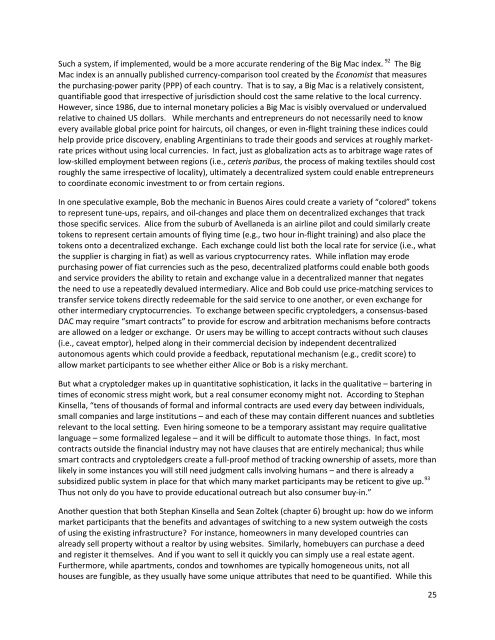Great+Chain+of+Numbers+A+Guide+to+Smart+Contracts,+Smart+Property+and+Trustless+Asset+Management+-+Tim+Swanson
Great+Chain+of+Numbers+A+Guide+to+Smart+Contracts,+Smart+Property+and+Trustless+Asset+Management+-+Tim+Swanson
Great+Chain+of+Numbers+A+Guide+to+Smart+Contracts,+Smart+Property+and+Trustless+Asset+Management+-+Tim+Swanson
Create successful ePaper yourself
Turn your PDF publications into a flip-book with our unique Google optimized e-Paper software.
Such a system, if implemented, would be a more accurate rendering of the Big Mac index. 92 The Big<br />
Mac index is an annually published currency-comparison tool created by the Economist that measures<br />
the purchasing-power parity (PPP) of each country. That is to say, a Big Mac is a relatively consistent,<br />
quantifiable good that irrespective of jurisdiction should cost the same relative to the local currency.<br />
However, since 1986, due to internal monetary policies a Big Mac is visibly overvalued or undervalued<br />
relative to chained US dollars. While merchants and entrepreneurs do not necessarily need to know<br />
every available global price point for haircuts, oil changes, or even in-flight training these indices could<br />
help provide price discovery, enabling Argentinians to trade their goods and services at roughly marketrate<br />
prices without using local currencies. In fact, just as globalization acts as to arbitrage wage rates of<br />
low-skilled employment between regions (i.e., ceteris paribus, the process of making textiles should cost<br />
roughly the same irrespective of locality), ultimately a decentralized system could enable entrepreneurs<br />
to coordinate economic investment to or from certain regions.<br />
In one speculative example, Bob the mechanic in Buenos Aires could create a variety of “colored” tokens<br />
to represent tune-ups, repairs, and oil-changes and place them on decentralized exchanges that track<br />
those specific services. Alice from the suburb of Avellaneda is an airline pilot and could similarly create<br />
tokens to represent certain amounts of flying time (e.g., two hour in-flight training) and also place the<br />
tokens onto a decentralized exchange. Each exchange could list both the local rate for service (i.e., what<br />
the supplier is charging in fiat) as well as various cryptocurrency rates. While inflation may erode<br />
purchasing power of fiat currencies such as the peso, decentralized platforms could enable both goods<br />
and service providers the ability to retain and exchange value in a decentralized manner that negates<br />
the need to use a repeatedly devalued intermediary. Alice and Bob could use price-matching services to<br />
transfer service tokens directly redeemable for the said service to one another, or even exchange for<br />
other intermediary cryptocurrencies. To exchange between specific cryptoledgers, a consensus-based<br />
DAC may require “smart contracts” to provide for escrow and arbitration mechanisms before contracts<br />
are allowed on a ledger or exchange. Or users may be willing to accept contracts without such clauses<br />
(i.e., caveat emptor), helped along in their commercial decision by independent decentralized<br />
autonomous agents which could provide a feedback, reputational mechanism (e.g., credit score) to<br />
allow market participants to see whether either Alice or Bob is a risky merchant.<br />
But what a cryptoledger makes up in quantitative sophistication, it lacks in the qualitative – bartering in<br />
times of economic stress might work, but a real consumer economy might not. According to Stephan<br />
Kinsella, “tens of thousands of formal and informal contracts are used every day between individuals,<br />
small companies and large institutions – and each of these may contain different nuances and subtleties<br />
relevant to the local setting. Even hiring someone to be a temporary assistant may require qualitative<br />
language – some formalized legalese – and it will be difficult to automate those things. In fact, most<br />
contracts outside the financial industry may not have clauses that are entirely mechanical; thus while<br />
smart contracts and cryptoledgers create a full-proof method of tracking ownership of assets, more than<br />
likely in some instances you will still need judgment calls involving humans – and there is already a<br />
subsidized public system in place for that which many market participants may be reticent to give up. 93<br />
Thus not only do you have to provide educational outreach but also consumer buy-in.”<br />
Another question that both Stephan Kinsella and Sean Zoltek (chapter 6) brought up: how do we inform<br />
market participants that the benefits and advantages of switching to a new system outweigh the costs<br />
of using the existing infrastructure? For instance, homeowners in many developed countries can<br />
already sell property without a realtor by using websites. Similarly, homebuyers can purchase a deed<br />
and register it themselves. And if you want to sell it quickly you can simply use a real estate agent.<br />
Furthermore, while apartments, condos and townhomes are typically homogeneous units, not all<br />
houses are fungible, as they usually have some unique attributes that need to be quantified. While this<br />
25


